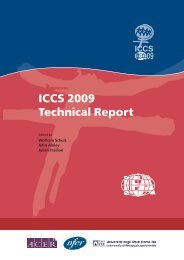Teacher Education and Development Study in Mathematics - IEA
Teacher Education and Development Study in Mathematics - IEA
Teacher Education and Development Study in Mathematics - IEA
You also want an ePaper? Increase the reach of your titles
YUMPU automatically turns print PDFs into web optimized ePapers that Google loves.
162<br />
TEACHER PAY AND STUDENT MATHEMATICS ACHIEVEMENT<br />
Figures 62 to 65 make the same po<strong>in</strong>t with reference to median earn<strong>in</strong>gs (<strong>in</strong>clud<strong>in</strong>g<br />
bonuses). Median earn<strong>in</strong>gs reflect earn<strong>in</strong>g differences at the “true” middle of the <strong>in</strong>come<br />
distribution. These earn<strong>in</strong>gs over a lifetime confirm the f<strong>in</strong>d<strong>in</strong>g that earn<strong>in</strong>g differences<br />
between mathematics-oriented professionals (scientists) <strong>and</strong> teachers <strong>in</strong>creased<br />
between 1996 <strong>and</strong> 2005, mak<strong>in</strong>g it more difficult <strong>in</strong> 2005 to recruit persons skilled <strong>and</strong><br />
knowledgeable <strong>in</strong> mathematics <strong>and</strong> science <strong>in</strong>to teach<strong>in</strong>g. The fact that teacher salaries<br />
fell from 1996 to 2005, whereas scientists’ salaries fell less severely <strong>and</strong>, for females,<br />
tended to <strong>in</strong>crease, suggests that the oversupply of teachers had a severe dampen<strong>in</strong>g<br />
effect on teacher <strong>in</strong>come <strong>in</strong> Thail<strong>and</strong>.<br />
It is unusual to see decl<strong>in</strong><strong>in</strong>g <strong>in</strong>comes for university graduates <strong>in</strong> any country dur<strong>in</strong>g<br />
this period, but <strong>in</strong> 1997, the Southeast Asian f<strong>in</strong>ancial crisis produced a sharp recession<br />
<strong>in</strong> Thail<strong>and</strong> that drove down most wages over the next year. Our data make clear that<br />
teacher salaries <strong>and</strong> non-scientist salaries did not recover by 2005, <strong>and</strong> that whereas<br />
scientists’ salaries also did not recover, female scientists, much more than female nonscientists,<br />
did some catch<strong>in</strong>g up salary-wise with male scientists. However, a fairly large<br />
gap <strong>in</strong> earn<strong>in</strong>gs between the two types of occupations for both males <strong>and</strong> females was<br />
very much <strong>in</strong> evidence.<br />
Figure 62: Thail<strong>and</strong>, Median Monthly Earn<strong>in</strong>gs of Males with Bachelor’s Degree, by Age<br />
<strong>and</strong> Occupation, 1996<br />
900<br />
Monthly Eaarn<strong>in</strong>gs (current US dollars)<br />
800<br />
700<br />
600<br />
500<br />
400<br />
300<br />
200<br />
100<br />
0<br />
20–24<br />
Scientists<br />
25–29<br />
30–34 35–44 45–54 55–64<br />
Age Group<br />
<strong>Teacher</strong>s<br />
Non-Scientists

















